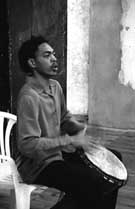INTERVIEW WITH GRAHAM FALKEN, CO-DIRECTOR OF AMAC, CAPE TOWN (SOUTH AFRICA)

Artfactories : The 27th of February you will change name and building. What
represent this change regarding your past activities - please let us know about
what you used to do- and what are the new challenges to come ?
Graham Falken : The naming ceremony will now take place next week on the 5th March. In many ways this merger is the logical outcome of the work we have been doing for many years.There is now more convergence between creative and cultural
disciplines.
Artfactories : How are you integrated to Cap Town’s cultural activities and what
is your relation to the population ? What is the relation of new technologies and south african people,and what do the AMAC plan to do regarding this issue ?

Graham Falken : ’Design’ itself epitomises this duality or unity. Artists want
access to new digital technologies. CAP has traditionally focussed on older
or more simple technologies while Mediaworks has sought to harness of new
technologies for both vocational training and community development.
CAP was the oldest active arts training NGO in south africa and is well
integrated into the cultural life of the city. It has drawn its students and
users from all the parts of the city and province , and before 1994, this
included other provinces as well. It was always an NGO which ’punched well
above its weight’ and has a strong national profile. This will be carried
forward into the new organisation.
The challenge today is still, after 10 years of democracy, to broaden access
into the arts for young people from the black communities of south africa.

For myself, I am very involved into advocacy work on behalf of our sector. I
serve on the national steering cttee of NACSA (Network for Arts and Culture
South Africa) , the Arts Cttee for the Cape Town Festival, Chair of Western
Cape Federation of Community Arts Centres (and national convenor for the
interim national cttee of the same org). My Co-Director Karen Thorne plays a
similarly active role in the community media sector.
In terms of new technologies and south africans- the Government is committed
to bridging the so called ’digital divide’ by rolling out an ambitious
programme of community media centres or telecentres. But as is often the
case with such large scale projects implementation is both slow and uneven.
AMAC’s role here is to form a kind of bridge between the people, especially
in the poor urban/rural areas and government so that people have the skills
to access the technologies becoming available to them. But we also have a
role in helping communities find ways to give expression to their issues,
problems and grievances using arts and media as tools.
Artfactories : How does the centre see itself in relation with others African
centres, and at international level ? In May, you will participate on the "seminar for emerging place of culture on the African continent" in Dakar, what do you expect of this gathering?

Graham Falken : In relation to Africa- we are members of INCD and recognised by UNESCO. We are building links with our neighbours in SADC and further afield.
We have a policy of offering internships and placements to people from all
over the world. We currently have a volunteer from Kenya - an IT
professional - working in our design studio.
If I am fortunate to attend the gathering in Dakar , I hope to make
connections with my colleagues involved in similar work so that we may share
strategies and solutions. I also hope to draw inspiration from the different
views and approaches I will encounter. For too long south africa was
isolated , by Apartheid, from its brothers and sisters in the rest of
Africa. We are just beginning to make up for lost time!



